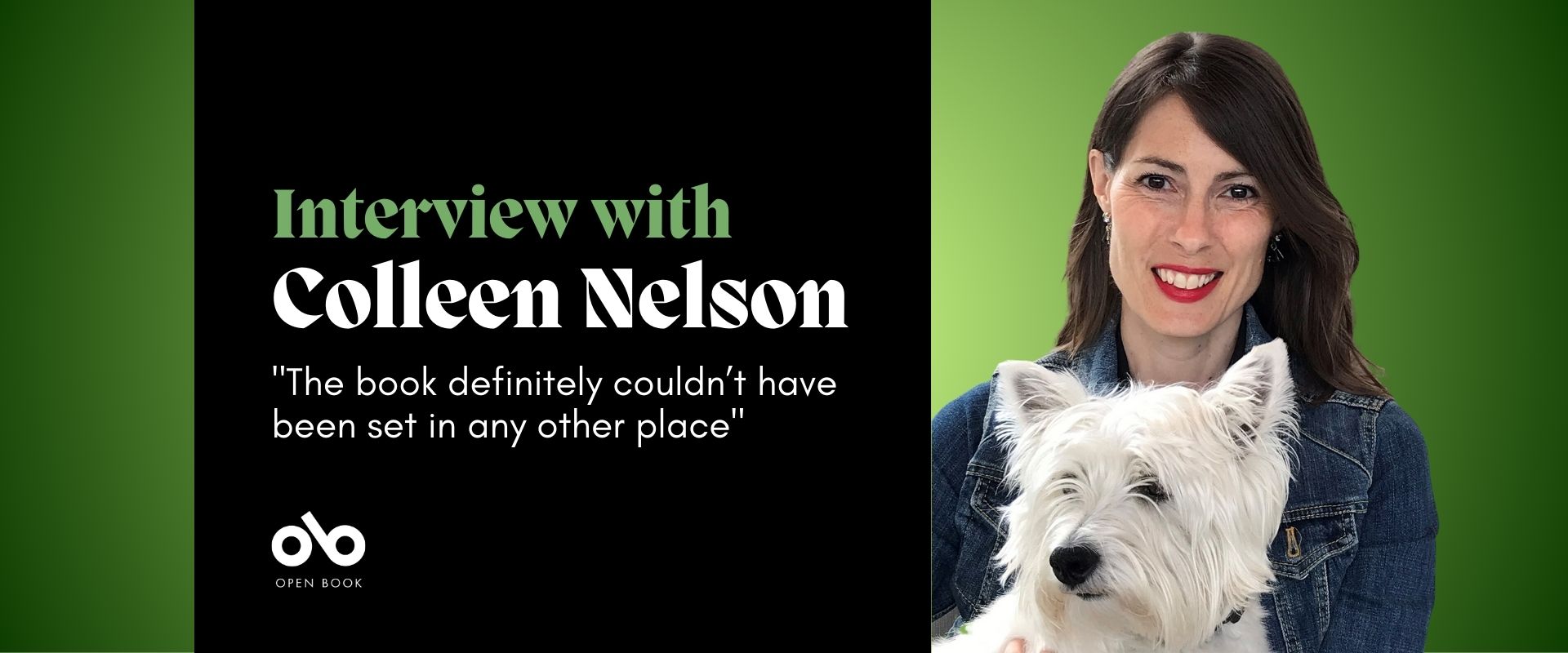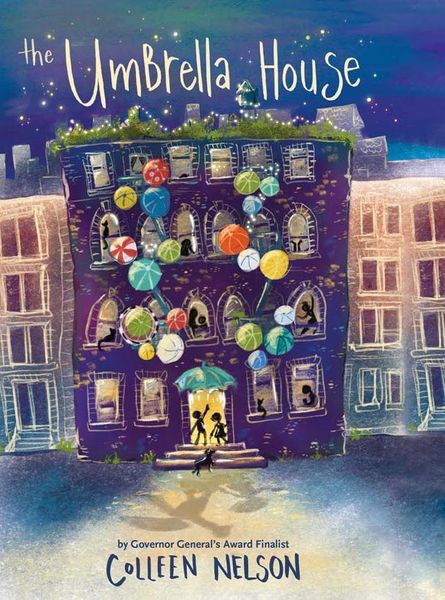Colleen Nelson on Setting Her New Kids' Novel in One of New York's Most Unique Historical Properties
Umbrella House in New York City is a unique urban phenomenon. Abandoned in the late 70s, it was sealed up with cinderblocks and cement until several years later when a group of squatters moved in. Over the years, the squatters not only renovated the building to make it livable, but eventually created a functioning co-op that continues to this day. In a remarkable turn of events in 2002, Umbrella House became one of eleven squatted buildings sold to their occupants for one dollar per resident.
It's against this backdrop of urban revolution that Colleen Nelson set her new middle grade novel, appropriately called The Umbrella House (Pajama Press). Following middle schooler Ruby Markowski, the novel tells a story of resistance and community. Ruby and her best friend Scout idolize the writers at local progressive media company Veracity News, and when the outlet announces a video competition for budding young journalists, Ruby jumps at the chance to find a story she's passionate about sharing.
She finds just the thing when her home, Umbrella House, comes under fire from an unscrupulous developer. She sets out to create a documentary about the Umbrella House residents, telling their unique stories and—hopefully—saving their shared home.
Nelson, who lived in New York for many years, draws on her knowledge of and love for the city to create Ruby's world as a richly detailed, fascinating urban community.
In speaking with us today as part of our Long Story interview for novelists, she tells us about her own New York years and her connection to Ruby's East Village neighbourhood, how her love for the book's cover (designed by Peggy Collins) motivated her during the editing process, and how a particular piece of advice from her publisher saved the book and solved an issue Nelson had worried was unsolvable.
Open Book:
How did you choose the setting of your novel? What connection, if any, did you have to the setting when you began writing?
Colleen Nelson:
Umbrella House is based on a real building located in the East Village of New York City, so the book definitely couldn’t have been set in any other place!
I lived in New York for many years and was a docent at a small museum very near to the East Village. Our apartment was about fifty blocks away, but I’d often walk to the museum so I could explore the city. I loved how each neighbourhood had such a different feel. The East Village was the area I connected with the most. I liked its authenticity, artsy vibe and unique history. Unlike some of the more polished areas of the city, the East Village is a rambunctious mix of restaurants, shops, bodegas, galleries, and apartment buildings. There are graffiti-covered walls, murals honouring it as the birthplace of punk rock music, and so much energy. It’s a place anyone can feel at home. For a long time, it’s been the place artists flock to, both because of its vibrant arts scene, but also for its reasonable rents. Unfortunately, this is changing due to gentrification.
As I researched more about gentrification and the history of the East Village, I discovered the story of the squats. In the late 1980’s, landlords stopped maintaining and paying taxes on their properties, leaving them abandoned. The city boarded them up, filled the pipes with cement and cut holes in the roof to deter squatters, people who moved in illegally. It didn’t work. People needed a place to live, so they used sledgehammers to break through the cinderblock doors. They were even willing to walk around with umbrellas when it rained because a roof with holes was still better than no roof at all.
Some of the squatters started to fix up the buildings, which is what happened to Umbrella House. It took years, but over time the roof was patched, plumbing and electricity was installed and the once-abandoned building became a home. As the squatters transformed the building, the city tried to kick them out, claiming they had no legal right to live there. The squatters went to court and argued that since they’d made so many improvements to the building, they should be allowed to stay. The judge agreed and the squatters were allowed to buy their apartments for $1 each!
Your CanLit News
Subscribe to Open Book’s newsletter to get local book events, literary content, writing tips, and more in your inbox
The Umbrella House is set in the present day when the building is once again under threat, this time from a property developer. And once again, the residents of the building, led by the young protagonists, must fight to keep their home.
OB:
Did you do any specific research for this novel? Tell us a bit about that process.
CN:
I did SO much research for this novel! I needed to ensure the details were accurate and do the real-life folks from Umbrella House proud. I had planned to go back to New York to research but the Covid pandemic hit, sidelining my travel. Luckily, my step-daughter’s work takes her to New York often, so she became my eyes and ears on the ground. She took lots of photos and videos which helped make the setting authentic. Another important source was EV Grieve, a blog about the East Village. I scoured the photographs and articles for details. As for research about the Umbrella House building, that required a lot of online research. I’ve listed the sources I used in the back of the book. I wanted to make sure readers felt the deep commitment and sense of community the residents of Umbrella House have to the neighbourhood. This is a place they built with their sweat and devotion—their heart and soul has gone into it.
Thanks to the gorgeous cover by Peggy Collins, the book has got a lot of attention on social media. Some of the current residents reached out to me after seeing it online. They read the book just before it went to print and gave it their stamp of approval.
OB:
What was the strangest or most memorable moment or experience during the writing process for you?
CN:
Every book has its fair share of memorable moments, but for this one it was seeing the cover, designed by the amazingly talented Peggy Collins, the first time. She so perfectly captured the feel and energy of the story. While I was knee deep in never-ending revisions, I’d pull the cover up for inspiration. There was no way I could submit a sub-standard book with a cover like that!
OB:
Who did you dedicate your novel to, and why?
CN:
Love this question! This book is dedicated to my writer friends Maureen Fergus and Jodi Carmichael. I’m so lucky to have both of them in my life. Writing can be lonely and sometimes disheartening. Writers definitely need a good support network! Funnily enough, Maureen dedicated her most recent picture book, Princess Pru and the Ogre on the Hill, to Jodi and me. (No pressure, Jodi, but you owe us. ) There are lots of authors who I count as dear friends; I can’t think of a more supportive community of people. I like to say that ‘book people are the best people’ and I really think that’s true.
OB:
What if, anything, did you learn from writing this novel?
CN:
Of all my books, this was the one I thought might not see the light of day. As much as I loved the idea of the book, it was a s-t-r-u-g-g-l-e. I revised the text so many times, but something was off, and I couldn’t figure out what it was. It made me doubt my instincts as a writer and wonder if the whole project should be shelved. But then Gail Winskill, my publisher and all-around amazing human, suggested I drop a story line. All of a sudden, I had clarity! It was obvious this was where the book had gone wrong, but I wasn’t able to see it. When I got to work on yet another round of revisions, things clicked. The sparkle of the story came through and the book became what I’d hoped it would be.
Not every book is a smooth journey from inception to publication. Some have a lot of bumps along they way or take detours. In the case of The Umbrella House, I needed to pick up some passengers and get their input for the book to sing. While writing can be a solitary endeavour this book felt more like a team effort with everyone at Pajama Press chipping in to help get it to the finish line.
___________________________________
Colleen Nelson earned her Bachelor of Education from the University of Manitoba in her hometown of Winnipeg. Her previous novels include Blood Brothers, selected as the 2018 McNally Robinson Book of the Year for Young People, and Pulse Point, selected as one of the CBC’s Most Anticipated YA Books of 2018. Colleen writes daily in between appearances at hockey rinks and soccer fields in support of her two sports-loving sons.





